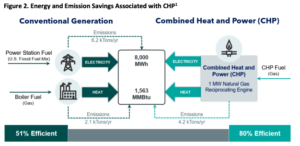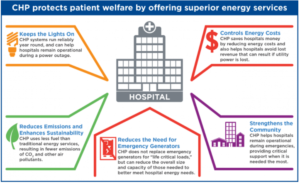By Lynn A. Kirshbaum, Deputy Director of the Combined Heat and Power Alliance
Tomorrow, October 7, is Energy Efficiency Day where we share information about the multiple benefits of energy efficiency. Energy efficiency is a cost-effective way to meet our energy needs, cut energy bills, and reduce pollution. Combined heat and power (CHP) systems are an efficient way to generate electric and thermal energy, helping to cut costs and reduce emissions while creating and sustaining jobs. The CHP Alliance joins numerous other organizations in acknowledging this important day.
The average efficiency of fossil-fueled power plants in the U.S. is 33 percent. This means that two-thirds of the energy used to produce electricity at most U.S. plants is wasted. When this electricity generation is combined with an on-site boiler for thermal energy needs, efficiency improves, but only to 50 percent.
ICF. “Combined Heat and Power Potential for Carbon Emission Reductions: National Assessment 2020-2050.” July 2020.

Energy and Emission Savings Associated with CHP
CHP systems are efficient electric and thermal energy generation units that can reduce energy costs. Improvements in CHP technology over time have resulted in properly designed CHP systems typically operating with an overall efficiency of 65-85 percent, with some approaching 90 percent. This is compared to an overall efficiency of only 45-55 percent when electricity and thermal energy are provided separately. CHP systems achieve these high efficiencies by recovering the waste heat by-product of electricity generation as useful thermal energy for heating and cooling. Currently, CHP comprises about 8 percent of the electric generating capacity in the U.S., but the U.S. EPA estimates there is more than 240 GW of technical potential at over 291,000 sites across the country.
Getting more energy outputs from the same fuel inputs reduces energy costs. In addition, since CHP systems are typically located close to where the electric and thermal energy will be used, savings are also achieved from reduced line losses, electricity that is typically lost during transmission and distribution from a central power plant to the end user.
The efficiency that CHP systems are able to achieve also allows them to reduce emissions. Because CHP systems combust less fuel to provide the same energy services, they reduce all types of emissions, including greenhouse gases, criteria pollutants, and hazardous air pollutants.
CHP systems can be used in a variety of settings. At critical infrastructure facilities such as hospitals and nursing homes and colleges and universities, CHP systems can save facilities money on their energy costs that can then be used to further their core mission, all while helping these facilities reduce their greenhouse gas and other emissions. At manufacturing and other industrial facilities, CHP systems can help to make these plants cost competitive by reducing their energy costs, while helping companies to achieve their environmental and emissions goals.
United States Environmental Protection Agency. “CHP for Hospitals: Superior Energy for Superior Patient Care.“

CHP Protects Patient Welfare by Offering Superior Energy Services
According to the National Association of State Energy Officials (NASEO) and the Energy Futures Initiative (EFI) 2020 U.S. Energy and Employment Report, as of 2019 the CHP industry employed 30,342 workers, about three percent of total electric power generation employment. According to the report, the CHP industry has a relatively diverse workforce: thirty-two percent of the CHP workforce in 2019 was female, while racial minorities made up 28 percent of CHP industry workers, compared to just 22 percent in the electric power generation sector as a whole.
In addition, the CHP industry employs people across business sectors. While professional and business services workers made up 60 percent of CHP jobs in 2019, the industry also employed a significant number in construction, manufacturing, and wholesale trade. This large concentration of workers in the professional and business services industry is the result of small generation capacities as well as overlap with other sectors, since many companies that have a CHP system will report based on the underlying fuel source.
CHP systems are highly efficient and can help facilities save money, cut pollution, and create jobs. The CHP Alliance is proud to work with other organizations on Energy Efficiency Day, and to bring awareness to the efficiency benefits of CHP systems all year round.
